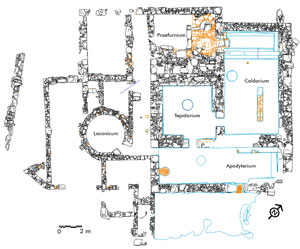 The public
baths of Ca l’Arnau, as they are called in scholarly literature, were
identified in 1997 and almost entirely excavated the
following year, while a number of other buildings were
identified without full excavation. This complex has
already been the subject of a significant number of
publications. At the time that it was abandoned it
consisted of four main rooms: an apodyterium,
tepidarium, caldarium, with shared
alveus, and laconicum. Other rooms with a
service function, or related to heating the complex
(furnaces, water storage, etc.), have also been documented.
A large area at the southern end of the complex is of
particular interest. It was annexed as an extension to the
complex during one of several remodeling phases that are
still being studied. At present, it is uncertain whether
this extension coincided with the construction of the
laconicum, or whether these were two independent
building phases.
The public
baths of Ca l’Arnau, as they are called in scholarly literature, were
identified in 1997 and almost entirely excavated the
following year, while a number of other buildings were
identified without full excavation. This complex has
already been the subject of a significant number of
publications. At the time that it was abandoned it
consisted of four main rooms: an apodyterium,
tepidarium, caldarium, with shared
alveus, and laconicum. Other rooms with a
service function, or related to heating the complex
(furnaces, water storage, etc.), have also been documented.
A large area at the southern end of the complex is of
particular interest. It was annexed as an extension to the
complex during one of several remodeling phases that are
still being studied. At present, it is uncertain whether
this extension coincided with the construction of the
laconicum, or whether these were two independent
building phases.
Although many typological and architectural questions remain unanswered, the overall interpretation and chronology of the building is clear. Especially complex is understanding the construction of the roof of the caldarium and the tepidarium, which seems to have been made of tapered tubuli, coated inside and outside with lime mortar, and strengthened with a framework of iron rods. The baths were constructed in about 150 B.C.E. and abandoned during the 90s B.C.E. They are one of the very few comparable bathing complexes located in the western Mediterranean. A comparison with the bath complex at La Almoina, in modern Valencia, is particularly instructive. These baths do not have a laconicum, but the layout and shape of the rooms, especially the caldarium, alveus and hypocaustum, seem to faithfully reproduce the model of the Ca l’Arnau baths.
The content displayed on this page reproduces, with permission of the author and the journal, fragments of the following article: Sinner, A. G. “Cultural contacts and identity construction: a colonial context in NE Spain (2nd – early 1st c. B.C.),” Journal of Roman Archaeology 28 (2015) 7-37.
References:
Martín, A. and García, J. “La vall de Cabrera de Mar. Focus inicials de la producció vitivinícola de la Laietània,” Pottery workshops and agricultural productions.Studies on the rural world in the Roman period 2 (Gerona 2007) 70.
García, J., Martín, A., and Cela, X. “Nuevas aportaciones sobre la romanización en el territorio de Iluro (Hispania Tarraconensis),” Empúries 52 (2000) 29-54.